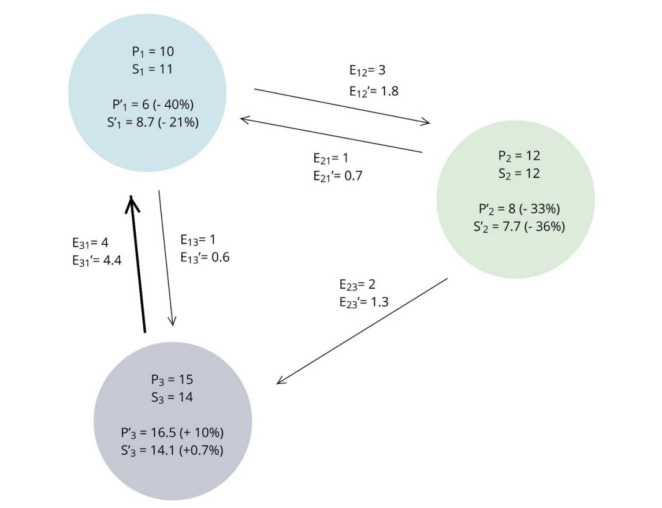Impacts of climate change on global food trade networks

Introduction
Countries’ reliance on global food trade networks implies that regionally different climate change impacts on crop yields will be transmitted across borders. This redistribution constitutes a significant challenge for climate adaptation planning and may affect how countries engage in cooperative action.
This paper investigates the long-term (2070–2099) potential impacts of climate change on global food trade networks of three key crops: wheat, rice and maize.Combining trade and climate impact data, the authors propose a baseline model for analysing potential structural redistributions of global food trade networks as a consequence of climate-induced production changes. They then test the model for the three crops and develop projections by linking data on future climate impacts and current trade. This analysis is not a prediction of future trade. Rather, it is a baseline approach that can generate knowledge on how the trade system may need to reconfigure to manage future climate impacts, and the level to which the current food trade system is prepared for climate risks.The study’s approach is useful to provide insights about the level to which the current food trade system is prepared for climate risks.
*This article is an abridged version of the original text”Impacts of climate change on global food trade networks“published in Environmental Research Letters, 17, under the CC BY license in December 2022 © Hedlund et al. Please note that references have been removed.For more detail, full references, and to quote text please use the paper available for download on the right.
Methods and Materials
The model:
The study explores structural disruptions of global food trade networks by applying climate change impacts on production of wheat, rice and maize, and proportionally on trade. The authors hypothesise that climate change impacts on production might force a structural change in food trade networks, indirectly leading to cross-border disruptions in imports to other countries. To isolate the effect of climate change impacts on production and trade they develop a simplistic model. In their model, impacts on yields equal impacts on production and export–import flows. Everything else is assumed to not change and no other mechanisms increase supply.

Analysis:
The analysis consists of three steps:
- First, the stability (or lack thereof) of trade communities under climate change-affected crop production of wheat, rice and maize was analysed.
- Second, the potential changes in countries’ network positions, or ‘roles’, in the food trade networks were studied.
- Third, the study identifies how exposed individual countries are to changes in yield production and imports and the potential role of trade communities in balancing production loss.
Refer to the full journal article (pages 2-5) to explore the model and data sources further.
Key findings
The study identifies potential disruptions in food trade networks taking point-of-origin-to-point-of-destination trade movements into account. The strength of this method is to, through a transparent and tractable modelling approach, provide insight into how current trade patterns may be reoriented as a result of projected climate change impacts:
- The model projects high stability of trade community structures under climate change. Only for maize a more substantial change can be observed.
- The movement of major global producers between communities, as exemplified by Vietnam and rice (changes trade community from a community with four of the major global producers, to a community with only two major producers, albeit the biggest one, China), indicates that trade relationships may change despite overall stability of global trade structures.
- These results show that a country’s future trade-linked climate vulnerability will be a combined effect of yield change and the balance of production loss or gain among trade partners.
- The model also illustrates how the distribution of cross-border production change in a community may be a determinant of vulnerability for individual countries. For example, Mali and Saudi Arabia face wheat production loss, but imports from existing trade partners may maintain available supply.
- The results indicate that trade as an adaptation mechanism may be more viable for wheat and rice than it is for maize.

Read about the results and key findings in-depth, and explore more data visuals on pages 5-8 in the journal article.
Reflections and Conclusions
Limitations and potential developments:
- The model is inherently limited by its simplicity. For example, it only allows for considering first-order cross-border impacts. Reduced food production resulting in increased market prices will likely however lead to higher-order direct and/or indirect effects, with a substantial impact on trade patterns.
- Future research could include economic modelling or the application of ‘discount factors’ to particular nodes to make them more likely to secure continued supply.
- Future analysis could also factor in the size and population of each country; in this study’s analysis, each country (node) is treated the same way.
- Another limitation in the study’s approach is that it utilises a future scenario with regards to atmospheric concentrations of greenhouse gases, and from this take projected future climate conditions and projected future impacts on crop yields. Yet, there is—in general—a need for combining impact scenarios with scenarios of how the future society might evolve e.g. behavioural change.
- Lastly, the extension of network models to include derived products would offer additional insight into these dependencies and their implications for climate change resilience.
Conclusion:
This study develops a simple network modelling approach to explore how current food trade between countries may be disrupted under long-term climate change impacts. The study complements previous work by focusing on climate change impacts on production and bilateral trade in global network structures.
The authors find that, for wheat and rice, the trade community structure is either stable (wheat) or only slightly changed (rice). According to the study’s model, countries with relatively large disruptions in both their domestic and trading partners’ production face the largest challenges in meeting their demand for all three crops, but particularly so for maize. The degree to which the food trade system can withstand climate risks may thus largely depend on countries’ abilities to balance production losses domestically and among vulnerable partners, relative reliance on specific crops, and relative levels of impacts differing between different producers and communities.
Taken together, this analysis of climate-induced changes of current food trade networks provides a baseline framework for more detailed study of potential threats to global food security, and—most importantly—highlights the need for international cooperation on adaptation.

Comments
There is no contentYou must be logged in to reply.